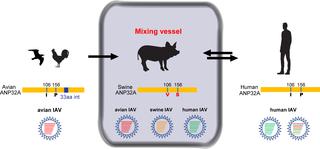当前位置:
X-MOL 学术
›
PLOS Pathog.
›
论文详情
Our official English website, www.x-mol.net, welcomes your
feedback! (Note: you will need to create a separate account there.)
A unique feature of swine ANP32A provides susceptibility to avian influenza virus infection in pigs.
PLoS Pathogens ( IF 5.5 ) Pub Date : 2020-02-21 , DOI: 10.1371/journal.ppat.1008330 Haili Zhang 1 , Hongxin Li 1 , Wenqiang Wang 2 , Yujie Wang 1 , Guan-Zhu Han 2 , Hualan Chen 1 , Xiaojun Wang 1
PLoS Pathogens ( IF 5.5 ) Pub Date : 2020-02-21 , DOI: 10.1371/journal.ppat.1008330 Haili Zhang 1 , Hongxin Li 1 , Wenqiang Wang 2 , Yujie Wang 1 , Guan-Zhu Han 2 , Hualan Chen 1 , Xiaojun Wang 1
Affiliation

|
Both the replication and transcription of the influenza virus are catalyzed by the viral polymerase complex. The polymerases of most avian influenza A viruses have poor performance in mammalian cells, which is considered to be one of the important species barriers. Pigs have been long considered as important intermediate hosts for interspecies transmission of the avian influenza virus, because of their susceptibility to infection with both avian and mammalian influenza viruses. However, the molecular basis of influenza polymerase adaptation in pigs remains largely unknown. ANP32A and ANP32B proteins have been identified as playing fundamental roles in influenza virus replication and host range determination. In this study, we found that swine ANP32A (swANP32A), unlike swine ANP32B or other mammalian ANP32A or B, shows stronger supporting activity to avian viral polymerase. Knockout of ANP32A in pig cells PK15 dramatically reduced avian influenza polymerase activity and viral infectivity, suggesting a unique feature of swANP32A in supporting avian influenza viral polymerase. This species-specific activity is mapped to two key sites, 106V and 156S, in swANP32A. Interestingly, the amino acid 106V is unique to pigs among all the vertebrate species studied, and when combined with 156S, exhibits positive epistasis in pigs. Mutation of 106V and 156S to the signature found in ANP32As from other mammalian species weakened the interaction between swANP32A and chicken viral polymerase, and reduced polymerase activity. Understanding the molecular basis of ANP32 proteins may help to discover new antiviral targets and design avian influenza resistant genome edited pigs.
中文翻译:

猪ANP32A的独特功能使猪容易感染禽流感病毒。
病毒聚合酶复合物可催化流感病毒的复制和转录。大多数禽流感A病毒的聚合酶在哺乳动物细胞中的性能较差,这被认为是重要的物种屏障之一。长期以来,人们一直认为猪是禽流感病毒种间传播的重要中间宿主,因为它们很容易感染禽流感和哺乳动物流感病毒。然而,猪中流感聚合酶适应的分子基础仍是未知之数。已确定ANP32A和ANP32B蛋白在流感病毒复制和宿主范围确定中起着基本作用。在这项研究中,我们发现猪ANP32A(swANP32A)与猪ANP32B或其他哺乳动物ANP32A或B不同,对禽病毒聚合酶显示出更强的支持活性。猪细胞PK15中的ANP32A敲除显着降低了禽流感聚合酶活性和病毒感染性,表明swANP32A在支持禽流感病毒聚合酶方面的独特功能。这种特定于物种的活动被映射到swANP32A中的两个关键位点106V和156S。有趣的是,氨基酸106V在所有研究的脊椎动物中是猪所特有的,当与156S结合使用时,在猪中表现出阳性上位性。106V和156S突变为其他哺乳动物物种在ANP32A中发现的标记,削弱了swANP32A与鸡病毒聚合酶之间的相互作用,并降低了聚合酶活性。
更新日期:2020-02-23
中文翻译:

猪ANP32A的独特功能使猪容易感染禽流感病毒。
病毒聚合酶复合物可催化流感病毒的复制和转录。大多数禽流感A病毒的聚合酶在哺乳动物细胞中的性能较差,这被认为是重要的物种屏障之一。长期以来,人们一直认为猪是禽流感病毒种间传播的重要中间宿主,因为它们很容易感染禽流感和哺乳动物流感病毒。然而,猪中流感聚合酶适应的分子基础仍是未知之数。已确定ANP32A和ANP32B蛋白在流感病毒复制和宿主范围确定中起着基本作用。在这项研究中,我们发现猪ANP32A(swANP32A)与猪ANP32B或其他哺乳动物ANP32A或B不同,对禽病毒聚合酶显示出更强的支持活性。猪细胞PK15中的ANP32A敲除显着降低了禽流感聚合酶活性和病毒感染性,表明swANP32A在支持禽流感病毒聚合酶方面的独特功能。这种特定于物种的活动被映射到swANP32A中的两个关键位点106V和156S。有趣的是,氨基酸106V在所有研究的脊椎动物中是猪所特有的,当与156S结合使用时,在猪中表现出阳性上位性。106V和156S突变为其他哺乳动物物种在ANP32A中发现的标记,削弱了swANP32A与鸡病毒聚合酶之间的相互作用,并降低了聚合酶活性。


















































 京公网安备 11010802027423号
京公网安备 11010802027423号